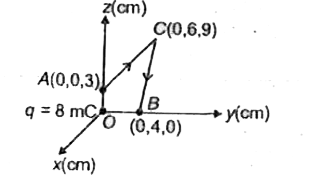If the work done in bringing a charge of 10−18C from infinity to point P is 2×10−17 J , what is the electric potential at P?
Step by step video solution for If the work done in bringing a charge of 10^(-18)C from infinity to point P is 2times10^(-17) J , what is the electric potential at P? by Physics experts to help you in doubts & scoring excellent marks in Class 12 exams.
Updated on:21/07/2023Similar Questions
If the work done in bringing a charge of 10−18C from infinity to point P is 2×10−17 J , what is the electric potential at P?
View SolutionHow much work will be done in bringing a charge of 400μC from infinity to some point P in the region of electric field ? Given that the electric potential at point P is 20 V ?
View Solution
Knowledge Check
In the question number 4, work done in bringing a charge of 4×10−9 C form infinity to that point is
A2.4×10−4JB1.8×10−4JC3.2×10−5JD4.1×10−5JCalculate the work done in taking a charge −2×10−9C from A to B via C (in diagram )
 A0.2 jouleB1.2 jouleC2.2 jouleDzero
A0.2 jouleB1.2 jouleC2.2 jouleDzeroThe work done in bringing a unit positive charge from infinity to the given point against the direction of electric intensity is
Aelectric potentialBmagnetic potentialCgravitational potentialDnone of these
(a) Calculate the potential at a point P due to a charge of 4×10−7C located 9 cm away.
(b) Hence obtain the work done in bringing a charge of 2×10−9C from infinity to the point P. Does the answer depend on the path along which the charge is brought ?
View SolutionThe work done in moving a charge of 2×10−9 C from a point of potential - 3000 V to another point P is 5×10−5J . Find the potential at the point P.
View SolutionThe work done in bringing 5 C of charge from infinity to a point A near a charged body is 20 J. Find the potential at point A.
View SolutionThe potential at a point is 20 V. The work done in bringing a charge of 0.5 C. from infinity to this point will be
View SolutionIf 6W is the work done in bringing a infinitesimal small test charge 6g from infinity to a point P, then potential at point P is
View Solution
